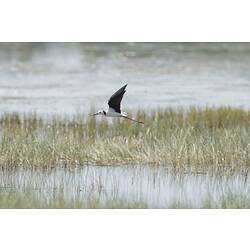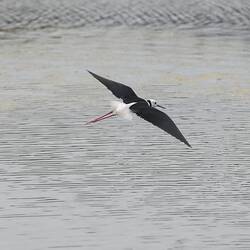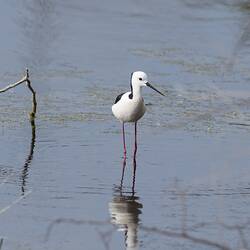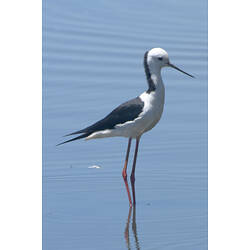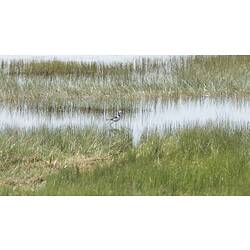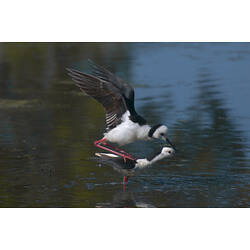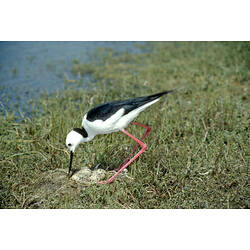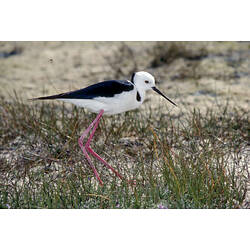General Description
A large wader with a white body and black wings and nape (back of the neck). The legs are long, slender and red. The bill is black, narrow and pointed. Bill to tail length up to 41 cm. The crown and nape of juveniles is whitish-grey. Black-winged Stilts look quite similar to Banded Stilts, Cladorhynchus leucocephalus, which are a similar species but have a wide chestnut band across their breast and a white nape.
Biology
Black-winged Stilts are a social species, often found in small groups. They breed from August until December in small colonies. Their nests range from a vegetation heap floating on or next to water, to a shallow depression in the ground. Breeding pairs aggressively defend their territory and both parents incubate the eggs and care for the chicks. They forage by wading in shallow water and capturing prey near or on the surface. They seldom swim when feeding, but can sometimes submerge their heads to catch food. They mainly eat aquatic insects but also eat crustaceans and molluscs. Black-winged Stilts have a high-pitched, repetitive barking call heard mostly when nesting. They are highly nomadic, moving in response to rainfall.
Distribution
Widespread throughout the South Pacific, Africa, Eurasia and the Americas. In Australia they are found in Tasmania and on the mainland, except in western deserts.
Habitat
Mudflats, estuaries, saltmarshes, swamps, and shallow river or lake margins.
More Information
-
Animal Type
-
Animal SubType
-
Brief Id
A white waterbird with black wings and a black patch at the back of the neck. Extremely long red legs.
-
Colours
White, Black
-
Maximum Size
41 cm
-
Habitats
-
Diet
Carnivore
-
Diet Categories
Crustaceans, Insects, Molluscs
-
Endemicity
-
Commercial
No
-
Conservation Statuses
CITES: Not listed, FFG Threatened List: Not listed, EPBC Act 1999: Not listed, IUCN Red List: Least Concern
-
Taxon Name
-
Common Name
Black-winged Stilt
-
Kingdom
-
Phylum
-
Subphylum
-
Class
-
Order
-
Family
-
Genus
-
Species Name
himantopus


